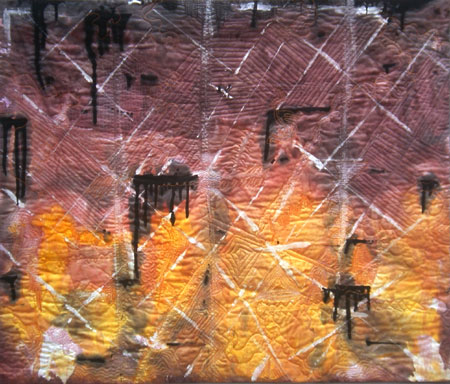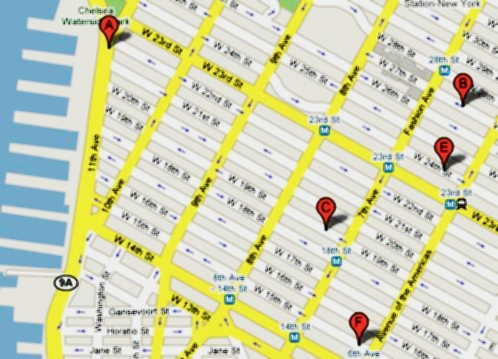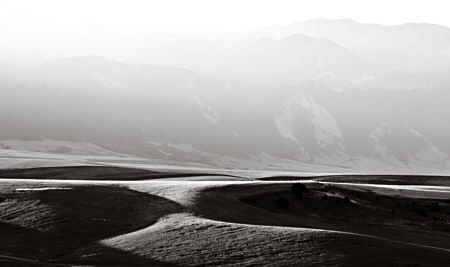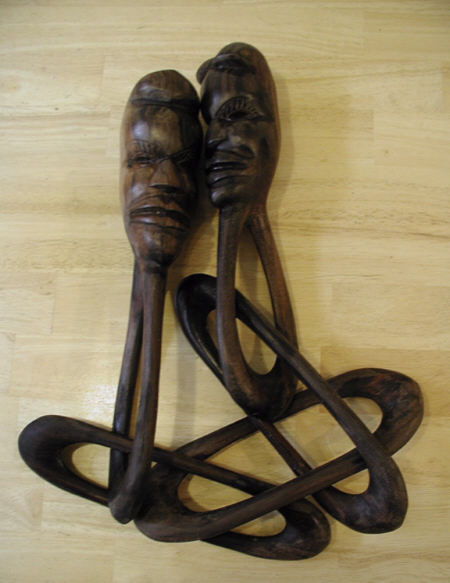Posted by June Underwood on May 25th, 2007

Farmland, 36 x 43, painted cotton
I have lived many places, and in each, I have always had a strong sense of the place itself — the trees and plants, the nature of the cultivated earth, the nature of the uncultivated earth, the sky, winds, air, light — I can describe all these with a fair amount of detail.
But I seldom had to try to recap in art what I know about a place where I no longer live. However, now I am doing so.
“Paint what’s around you,” seems to be a sound admonition, but what is around me is the opposite, environmentally speaking, of what I am painting. more… »
Posted by Sunil Gangadharan on May 24th, 2007
It was with much elation that I read an email sent out by a fairly prominent gallery (which will remain unnamed in this post) in Chelsea, NY last week announcing that they were happy to represent my work. I had entered an art competition sometime back hosted by the same gallery and I guess I must have caught someone’s eye to be ‘noticed’ by the gallery’s director. This was about the same time that we were having our second child (we had a baby boy and all are doing well) and I did not bother to read some of the fine print that the same email carried. Once things settled down a bit over the weekend, I decided to check the attached legalese and found out that the gallery representation came at a cost:
- Basic One-Year Representation ~ $3K (10 feet of exhibition space)
- Standard One-Year Representation ~ $5K (20 feet of space)
- Premium One-Year Representation ~ $10K (40 feet of space and review in some NY art publication)
All of the above options include the following ‘perks’
- Allow use of words “represented by Un-named Gallery” on resume.
- Director reserves right to establish prices for work.
- Representation on the gallery’s online site (~ 8 images)
I remember being a little confused. I was under the impression that galleries who decide to represent an individual’s work do it out of two things: 1) An understanding by the gallery that the work would attract buyers and it does make economic sense to exhibit 2) Genuine appreciation for the artwork submitted…
Maybe I am being too idealistic, but other than the gallery looking out to pay exorbitant Chelsea based rents in this case, I fail to see how ‘fee based tiered representations’ like the one described above would really help artists like me…
What are your thoughts, experiences and advice? Are all galleries like this? Is this the norm to break into Chelsea (especially in a superheated art environment like the one that we are living in)? For some reason, I do not think so (but I am just an amateur with little experience venturing out into the art exhibition space)…
Cartoon of an ‘Overheated art district’
Posted by Steve Durbin on May 22nd, 2007

Funny how things come together sometimes. After casting about for a while, rejecting various topic possibilities, I finally settled on one I’d had in mind for some time, although I hadn’t prepared images or written anything. After typing the title and while I was uploading images, I noticed Doug had just posted on influence. In part, this post is about what I can do here in Montana that is as much as possible like those fabulous images of California dunes (Oceano, Death Valley) by the Westons and many others (see examples here and here). I’m not exactly striving to copy, but I am deliberately letting that influence wash over me and through me. I love the forms of those high contrast black and white images, both the three-dimensional dune forms and the two-dimensional shapes in the plane. I look at those images often.
But there is another goal with my series, although I had not quite formulated it sharply until Birgit’s recent post. In addition to the dune-like undulating fields in the foreground, most of these images have the Bridger mountains in the background. But the mountains are serving not so much as subject as to bring out the light-filled air of early morning.
more… »
Posted by Doug Plummer on May 21st, 2007
Paul Butzi has a provocative series of posts on Musings, in his typically thoughtful style, about the necessity to seal himself off from influences, particularly the media. I have great respect for his thinking, but I offered a different take in a long comment on his recent post. I’m appropriating myself and posting it here.
Paul,
As I understand you position, you’re saying that in order to protect the integrity of your experience, you have to deliberately isolate yourself from stimulus that might become a mediating influence, because it deters and inhibits the sense of being in the moment.
My retort is twofold, one about artistic influences, and the other about mass media (we won’t talk about the intersection of these two sets, which is an interesting arena that a lot of artists use to make some important work, and always have). I contend that isolating yourself from other artistic influences is a big disservice to one’s own process.
My feeling is, that the more I know about what has gone on before me, the more roots there are to feed my own work. I visit museums and galleries whenever I travel, and I make it a priority. I have arenas of art work that I like to look at and that I respect, and large swaths that I pretty much ignore. But I don’t prohibit it from feeding my process. Even work I argue with grows me.
Allowing Italian Renaissance art into one’s process is one thing. Mass media is harder to defend. But much of the art I adore was the mass media of its era. I am writing this while I am watching my guilty pleasure, “Dancing With The Stars.” I’m working on a dance project. I’m interested in the popular culture take on dance, and I love that this show highlights and rewards a kind of (well, vulgur) virtuosity. Because I make a living from my artistic process, I pay attention to the trends and patterns in how the media mediates our culture back to ourselves.
I don’t like a lot of what I see, of course. That’s beside the point. Anyone with a lick of self respect is going to be majorly frustrated with the culture we live in. The way I inoculate myself from the media onslaught is to pay attention to it. I deconstruct how it works, what it’s trying to say, and the meta messages within it. But sometimes the production values speak to some of the best artistic output of our era. Or at least, it informs me about what is the visual vocabulary of our time.
Posted by Jay on May 21st, 2007
Picked up a piece of airport art at a garage sale. I believe that the lady said it was from Kenya. It is a chain, carved from a single piece of wood with a stylized head at each end.

more… »
Posted by Richard Rothstein on May 20th, 2007
Posted by Angela Ferreira on May 20th, 2007

Title: Give Peace a Chance
Size: 170 x 78 cm
Medium: Oil on Canvas
Description: Art that changes the World!






